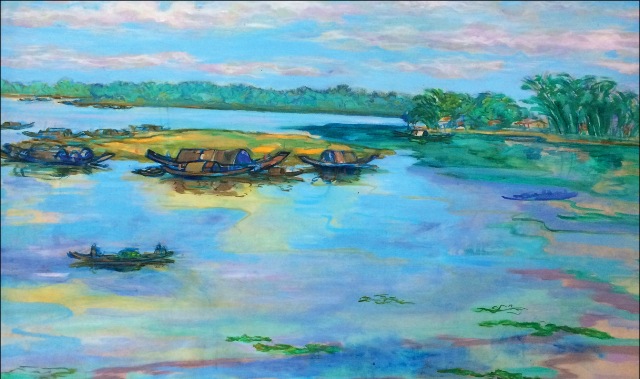
Afternoon on Perfume River
Inborn gift
A while later, his aunt, Mrs. Thai Thi Hue Khanh brought him to the wooden house on Hang Duong St. (Bach Dang St. now) from An Ninh Ha Village and took good care of him with her whole heart.
The Thai family with a history of more than 100 years inhabiting in the three ancient areas in Hue (An Ninh Ha, Kim Long-Ha Khe and Hang Duong) is well known for preserving values of ancient Hue such as garden houses, traditional costume, education and women of virtue in the clan.
As recorded by his younger sister Thai Kim Lan, Thai Ba's painting tendency revealed as early as when he was in primary school through his drawings of the family. It was the painter Ton That Dao who detected his gift and encouraged him to take up painting.
After finishing Quoc Hoc High School in Hue in October, 1955, Thai Ba passed the exam into Gia Dinh-Saigon National College of Arts and became a student of Le Van De, one of the typical neoclassical painters in South Vietnam at the time.
In 1958 Thai Ba won the silver prize in the Vietnam Tourist Propaganda Poster Contest and ranked the second place in his class with the theme of Four Woman's Virtues (industry, appearance, speech and behavior). His painting was displayed at the Museum of Art. Those accomplishments helped him win a scholarship to study at the National College of Arts in Paris, France in 1960.
After completing his studies in France in 1966, Thai Ba officially became a professional painter specializing in silk painting, oil painting, sketching, watercolor and Chinese-styled watercolor.
In 1969, he was sponsored by UNESCO to go to the United States and painted for UNICEF. During that time, his personal exhibition One Man Show was introduced widely in New York. He also painted for special magazines about Hue in the US such as Nho Hue (Missing Hue), Phuong Vy (Flamboyant), Co Do (Ancient Capital), Thua Thien-Hue, etc.

Phu Van Lau
A piece of the imperial capital
In her ancient house on Bach Dang St., Thai Kim Lan still preserves paintings by Thai Ba, painted in the 90s, the time when he regularly returned to Vietnam. Those are watercolors on paper, elegantly framed upon seeing which, everybody can recognize they are all about Hue.
Thai Ba's paintings reflect a combination of Thien (Heaven), Dia (Earth) and Nhan (human). They depict the typical dreamy color of the sky in Hue. He tended to employ delicate colors like blue, light purple and light yellow. Those colors were blurred into one another to form the dreamy air of Hue.
In his painting Afternoon on Huong River, Thai Ba employed the perspective technique of the romantic realism to reflect nature, more implying than depicting, using Leonardo de Vinci's Golden Ratios. The painting shows skillful techniques, mature shapes but familiar and friendly in emotion.
About the blue shade in Thai Ba's paintings, Prof. Thai Kim Lan calls it "the voice of the blue sky in the Linh Mu area in an early morning reflecting the green color of the water from the river combined with the ink blue color of Kim Phung Mountain in spring. Beholding these paintings, viewers wish they were covered with a layer of dust so that they would look more realistic, only to find that it was Thai Ba's original inspiration.”
One can see Thai Ba's modest love of fatherland in his paintings. He did not paint Hue in a splendid way, but in a rather calm and subtle manner. The painting Phu Van Lau is an example.
It captured a wide view including Ngu Binh Mountain and such royal constructions as the Flag Pole, Phu Van Lau and Nghinh Luong Dinh. But above all was the calmness of the river. Thai Ba wanted to depict typical Hue characters including nature, architecture and humans through the five royal colors (red, yellow, blue, green and purple).
Hue characters are expressed through tropical colors, rhythms and splendid lights. What is special about this painting is that though Thai Ba did not paint any human, the viewer can still feel human in it.
Story and photos: Nguyen Huong